Settings Database Editor¶
Requested by: |
AURA |
|---|---|
Doc. Code |
|
Editor: |
Julen Garcia |
Approved by: |
- |
Index¶
Introduction¶
This document contains the documentation for the SettingsDatabaseEditor application. This application can be used to
modify, create or remove settings in the database, as well as events, therefore, this application can be used only by
maintenance level users.
❗❗❗IMPORTANT❗❗❗: modifying, creating or removing either settings or events could affect the performance of the system. Therefore a good understanding of the code is needed before changing anything using this low level configuration tool.
Application location and launch¶
The application is installed in the MCC, the server that runs both the EUI and the database itself. This application can
be found at /usr/local/TMA_SettingsDatabaseEditor and is called SettingsDatabaseEditor.
Once the application is launched the first window looks like the following image, just wait until the user is requested.
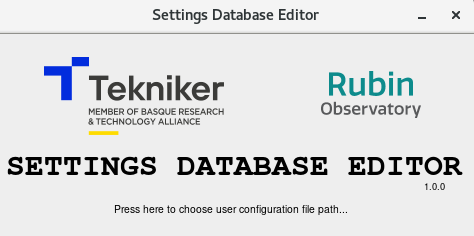
Only if the application fails for not finding the users definition file, press the button that says:
Press here to choose user configuration file path...
If everything goes as expected, a user and password are requested, see image below. To manage the database the logged in user must be a user with M_Maintenance privileges.
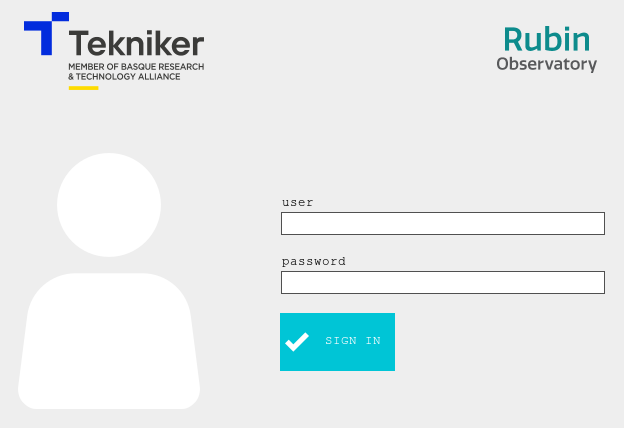
If the provided user is not a M_Maintenance user the application will return an error pop-up.
Once the user is entered correctly the settings and events management window is displayed, see image below.
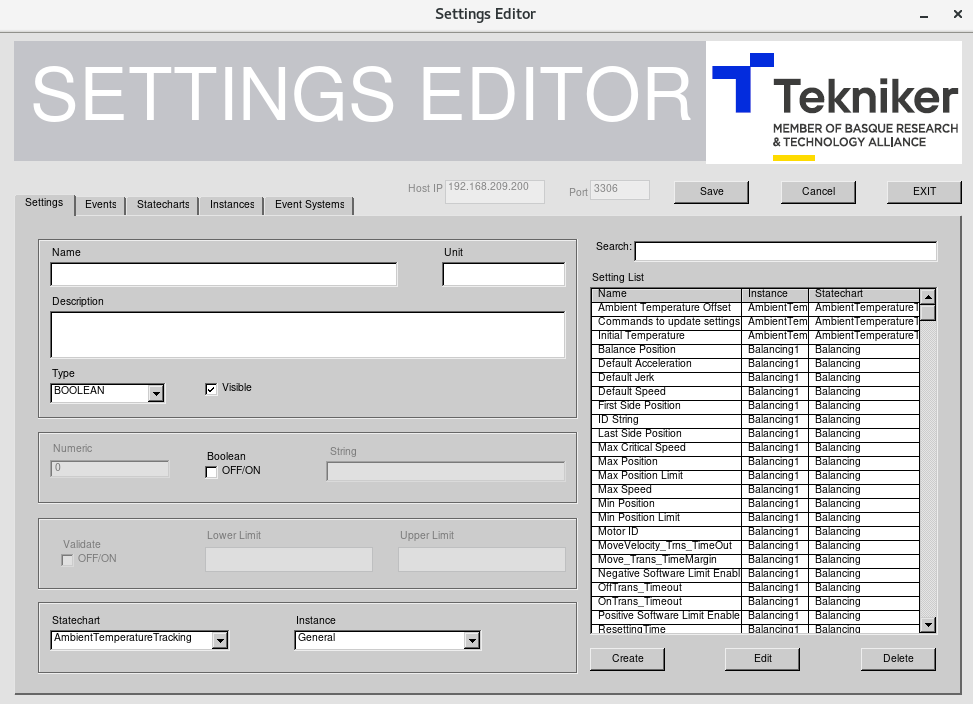
Application usage¶
The application has 5 tabs, this means 5 different sections for different actions, these actions are explained in independent sections below.
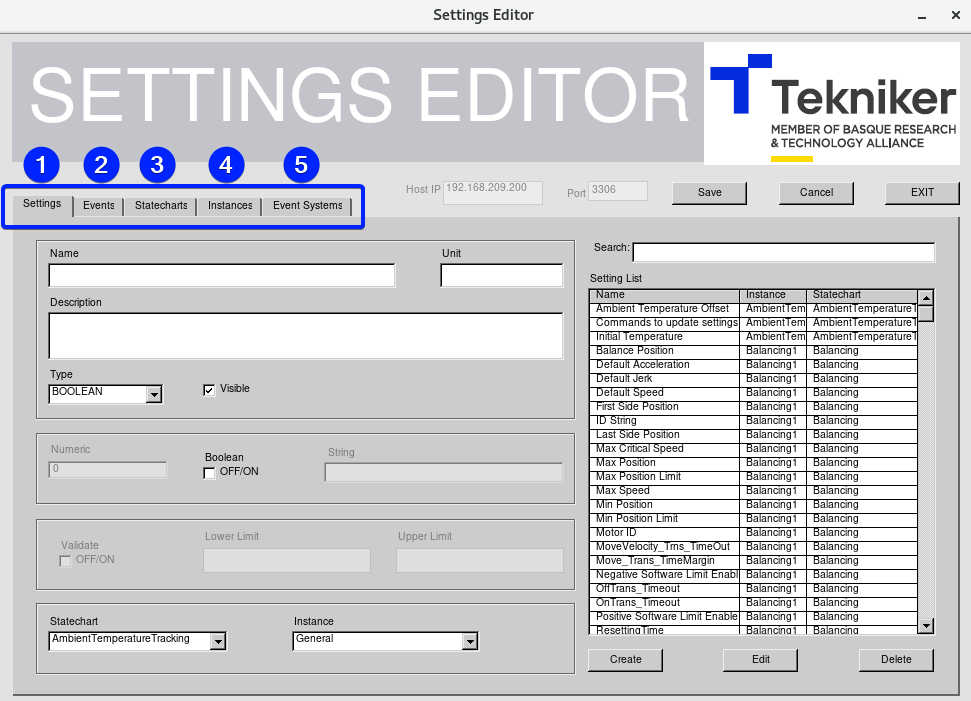
Settings tab¶
This is the default tab and is launched first by default, here settings can be modified, created or removed.
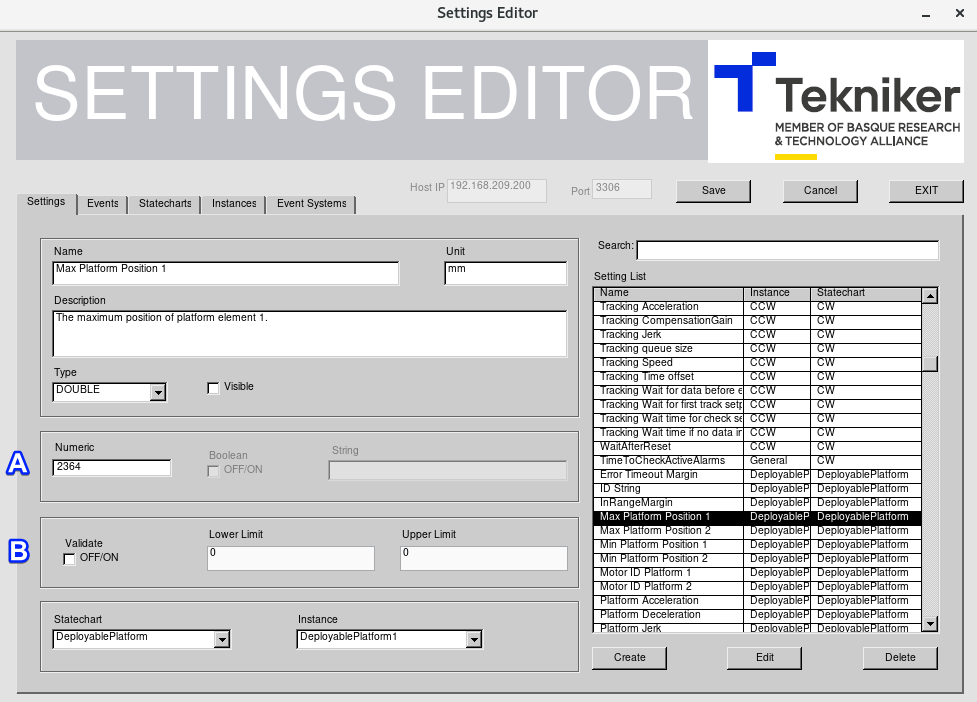
Modifying existing setting¶
Select the desired setting from the
Setting liston the right, this will load the related information on the left:Name: this is the setting name.
Unit: for specifying units, when needed.
Description: this is displayed in the EUI to help the users understand the settings purpose.
Visible: this is a true/false switch, for making these restricted or not.
Visible = true -> this setting is visible to all users.
Visible = false -> this setting is visible to high privilege users only, M_Maintenance users.
Type: this is an enum with three options, depending on the selected type, the controls below, in sections A and B fom the image above, will change accordingly.
Double: for double float settings.
Numeric: this is the value of the setting, this updates the saved value of the setting.
Validate: this is a true/false switch, when on the value entered in the EUI for the setting must be in between the provided range by Lower Limit and Upper Limit.
Boolean: for true/false settings
Boolean: this is a true/false switch for the setting value, this updates the saved value of the setting.
String: for string settings
String: this is a string control for the setting value, this updates the saved value of the setting.
Statechart: this is an enum defined in the Statecharts tab and related to the code in the PXIs, as each statechart is a different code module in the PXI code.
Instance: this is an enum defined in the Instances tab and related to the code in the PXIs, each instance is an instance of the related statechart code module.
Once the left part is updated to the desired values press the Edit button on the right.
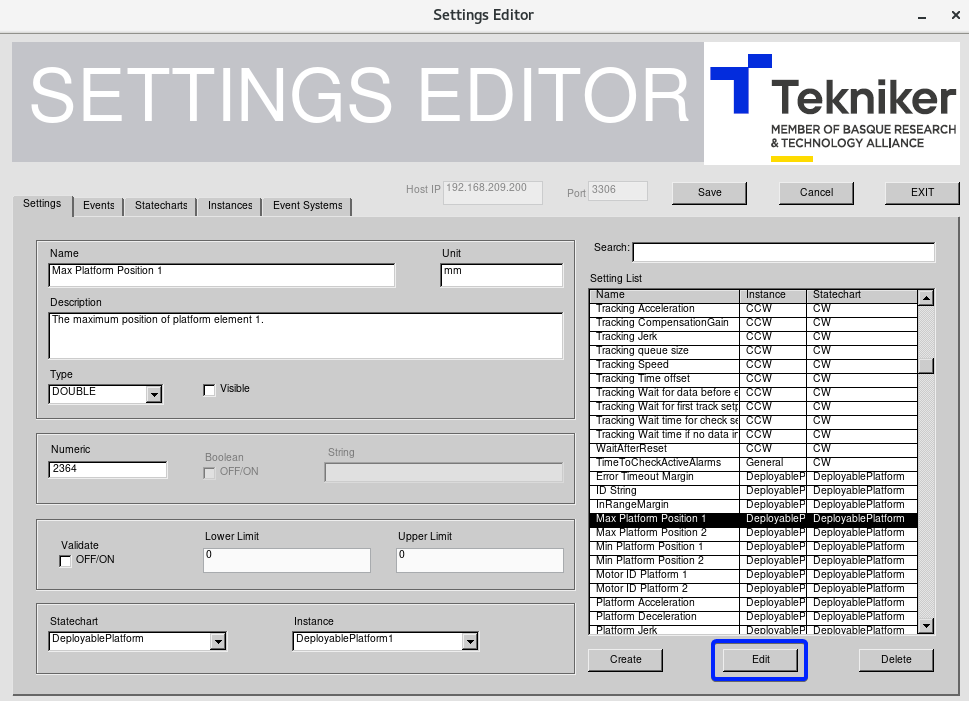
If more than one setting is going to be modified, repeat the first two steps.
When all the settings are modified press the Save button, top right of the application.
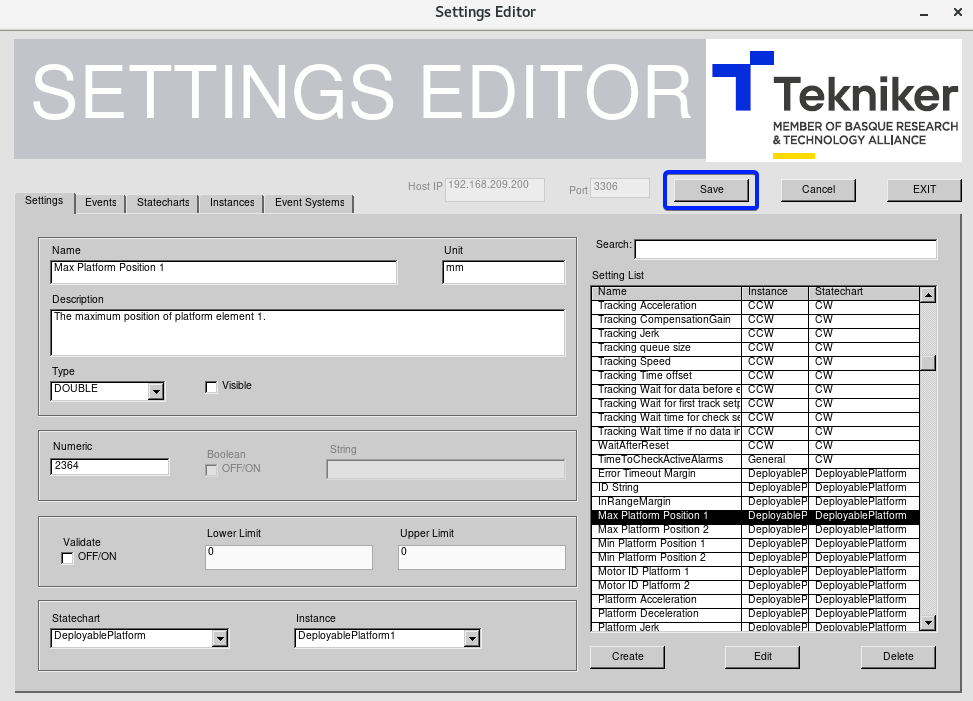
Create new setting¶
Fill all the fields needed from the left
Once the left part is updated to the desired values press the Create button on the right.
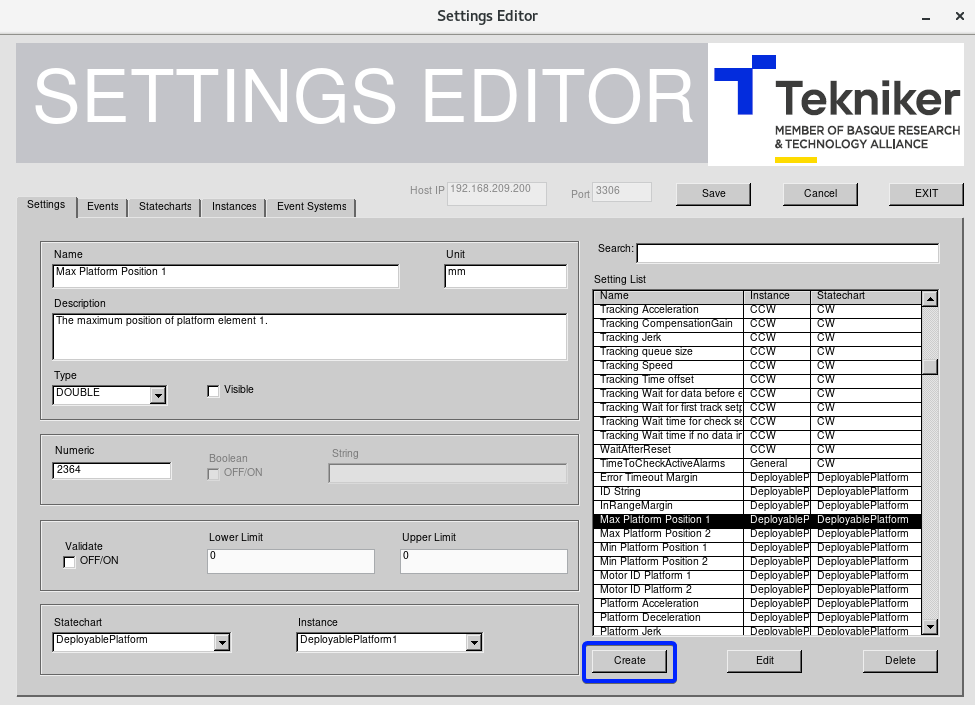
This will create the new setting
If more than one setting is going to be created, repeat the first two steps.
When all the settings are created press the Save button, top right of the application.

Remove existing setting¶
Select the desired setting from the
Setting liston the right.Press the Delete button on the right.
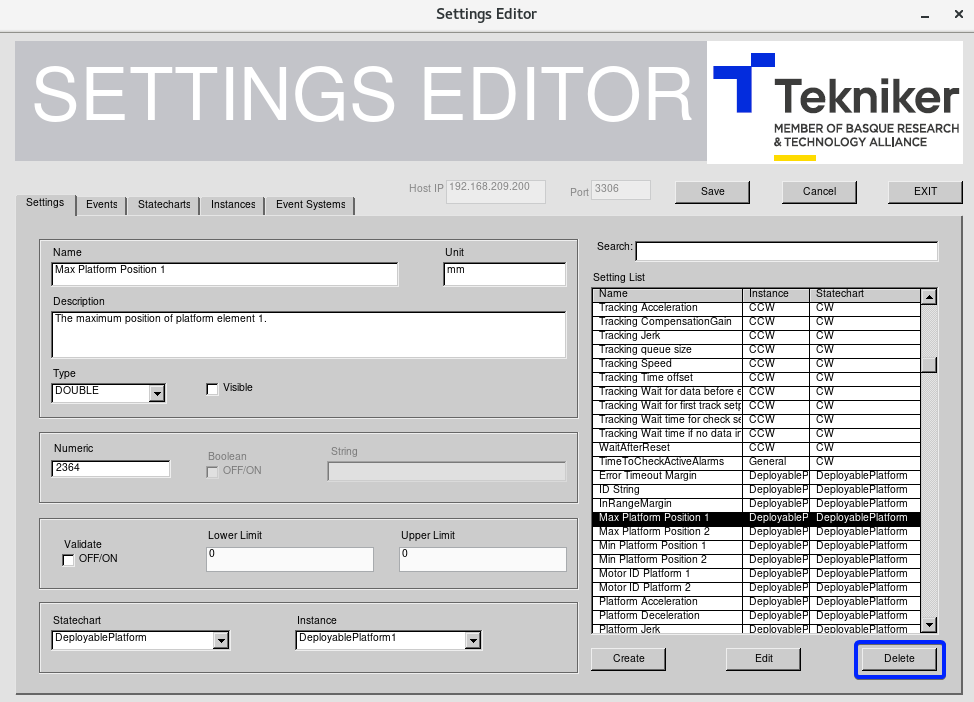
If more than one setting is going to be removed, repeat the first two steps.
When all the settings are modified press the Save button, top right of the application.

Events¶
Here the events managed by the event system can be modified, created or removed.
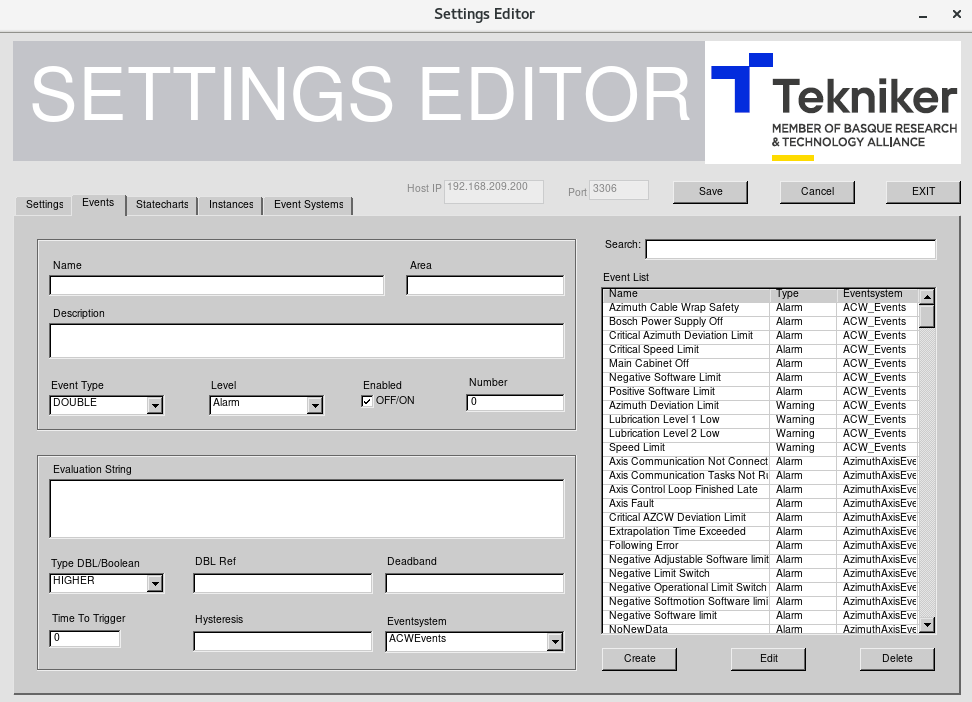
Modifying existing event¶
Select the desired event from the
Event liston the right, this will load the related information on the left:Name: this is the event name.
Area: this is for tracing the event, it must contain a number from the same series of the commands, then dot (.) and then the abbreviation for the subsystem.
Description: this is the explanation of the event that will be displayed in the EUI when tripped.
Type Event: this is an enum with two options, this updates the section below according to the selected type.
Boolean: for evaluation strings that result in a boolean true/false outcome.
Evaluation String: this is the evaluation string, that admits names from the related settings for the subsystem, when setting names are detected are painted red, and names that are provided in the code when sending the data to the event system are black.
Type DBL/Boolean: this is the type of checking done with the outcome of the evaluation string and compared to the BOOL Ref value. This is an enum with three values: EQUAL, CROSSING FROM, CROSSING TO.
BOOL Ref: this is the value that is compared to the outcome of the evaluation string depending on the type.
Double: for evaluation strings that result in a double numeric outcome.
Evaluation String: this is the evaluation string, that admits names from the related settings for the subsystem, when setting names are detected are painted red, and names that are provided in the code when sending the data to the event system are black.
Type DBL/Boolean: this is the type of checking done with the outcome of the evaluation string and compared to the DBL Ref value. This is an enum with four values: HIGHER, LOWER, EQUAL, NOT EQUAL.
DBL Ref: this is the value that is compared to the outcome of the evaluation string depending on the type.
Deadband: this is the deadband for the comparison when using the EQUAL or NOT EQUAL options from the Type DBL/Boolean enum. For example for a DBL ref value of 0, a type DBL of EQUAL and a deadband of 1 would mean that values between -1 and 1 will trip the event.
Hysteresis: this is the hysteresis for the comparison when using the HIGHER or LOWER options from the Type DBL/Boolean enum. For example for a DBL ref value of 0, a type DBL of HIGHER and a hysteresis of 1 would mean that values above 0 trip the event, but they must be below -1 to deactivate the event.
Eventsystem: this is an enum defined in the Event Systems tab and related to the code in the PXIs, as each eventsystem is related to a different code module in the PXI code.
Once the left part is updated to the desired values press the Edit button on the right.
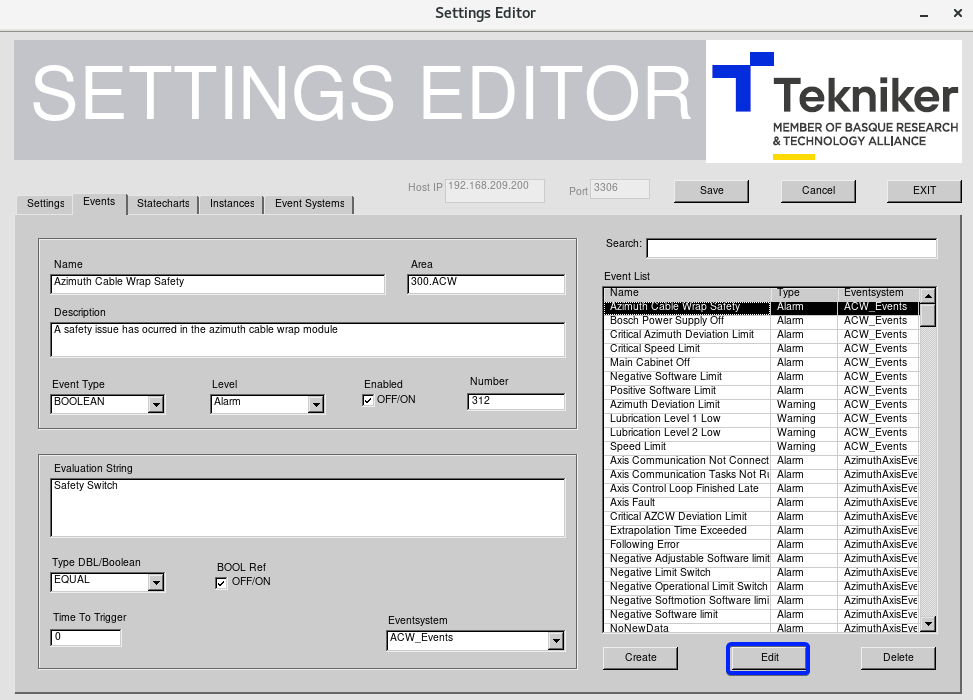
If more than one event is going to be modified, repeat the first two steps.
When all the events are modified press the Save button, top right of the application.

Create new event¶
Fill all the fields needed from the left
Once the left part is updated to the desired values press the Create button on the right.
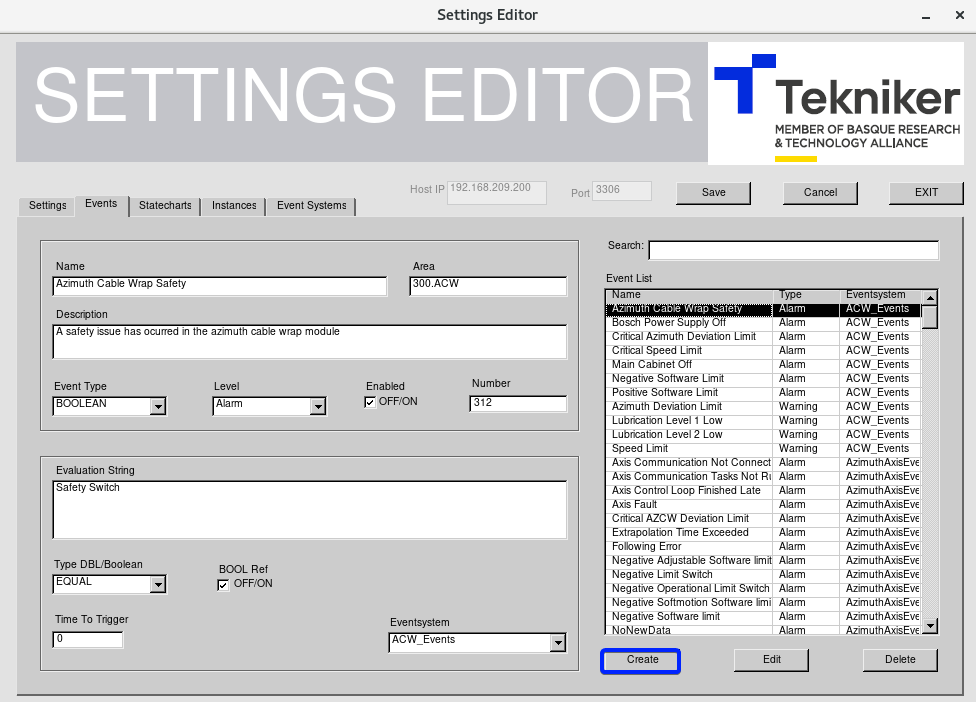
This will create the new event
If more than one event is going to be created, repeat the first two steps.
When all the events are created press the Save button, top right of the application.

Remove existing event¶
Select the desired event from the
Event liston the right.Press the Delete button on the right.
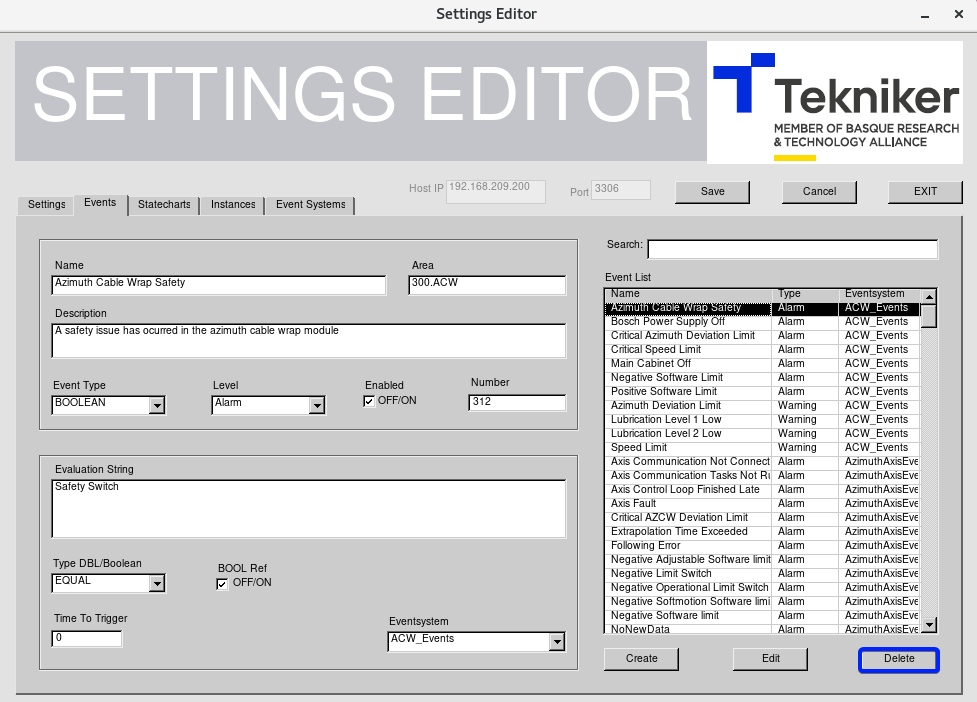
If more than one event is going to be removed, repeat the first two steps.
When all the events are modified press the Save button, top right of the application.

Statecharts¶
Here the statecharts that are going to be available for the settings are managed, created, modified and deleted.
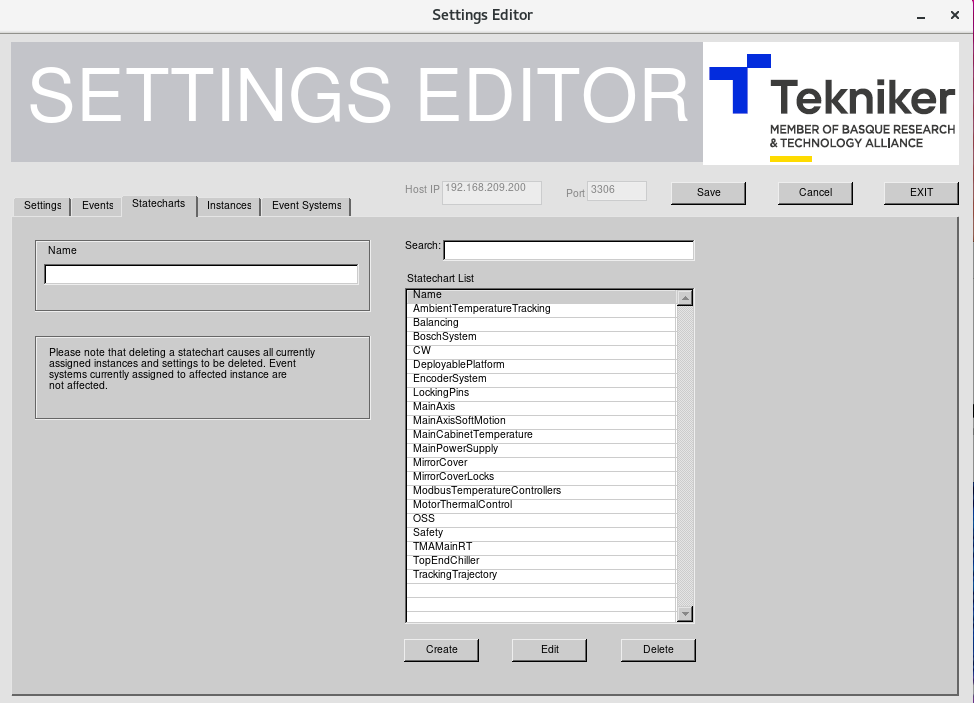
Modifying existing statechart¶
Select the desired statechart from the
Statechart liston the right, this will load the related information on the left:Name: this is the statechart name.
Once the left part is updated, the name is changed, press the Edit button on the right.
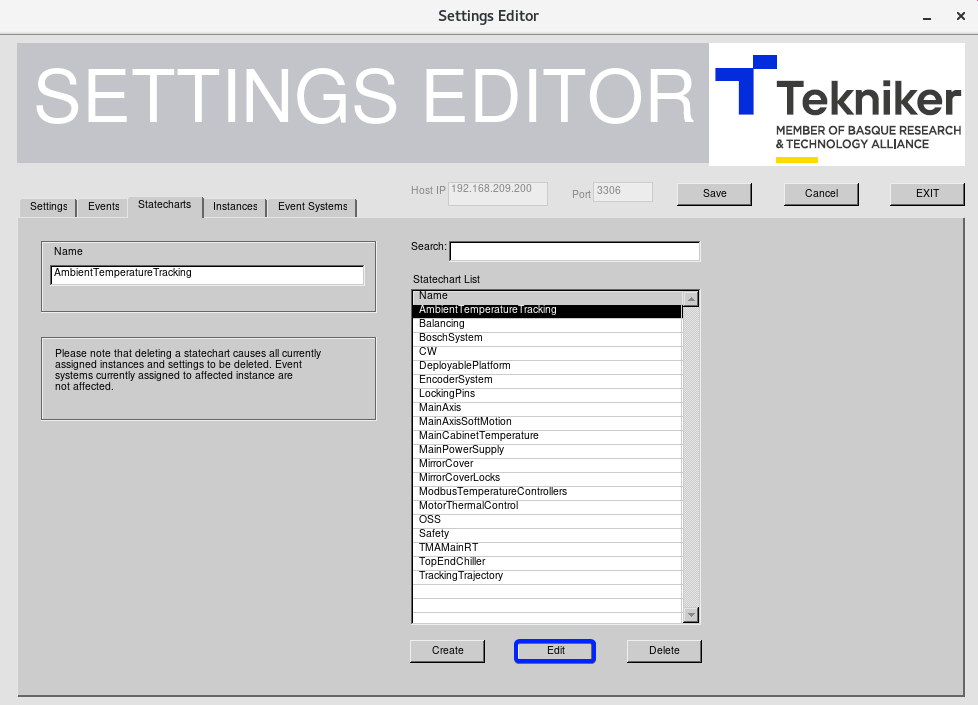
If more than one statechart is going to be modified, repeat the first two steps.
When all the statecharts are modified press the Save button, top right of the application.

Create new statechart¶
Add the name for the statechart.
Press the Create button on the right.
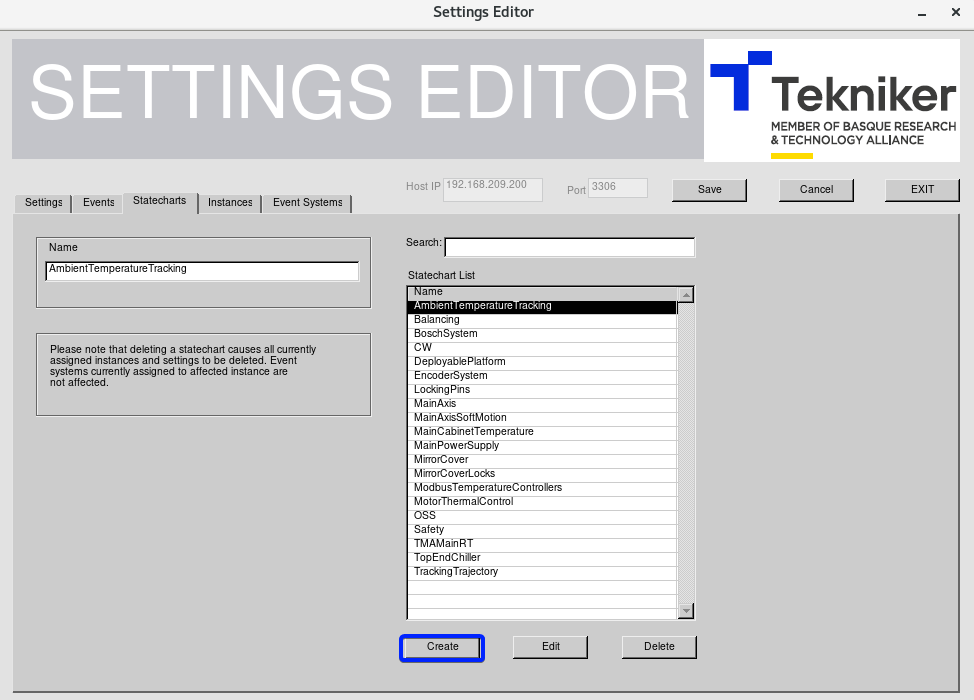
This will create the new statechart.
If more than one statechart is going to be created, repeat the first two steps.
When all the statecharts are created press the Save button, top right of the application.

Remove existing statechart¶
Note that deleting a statechart causes all currently assigned instances and settings to be deleted. Event systems assigned to the related instances are not affected.
Select the desired statechart from the
Statechart liston the right.Press the Delete button on the right.
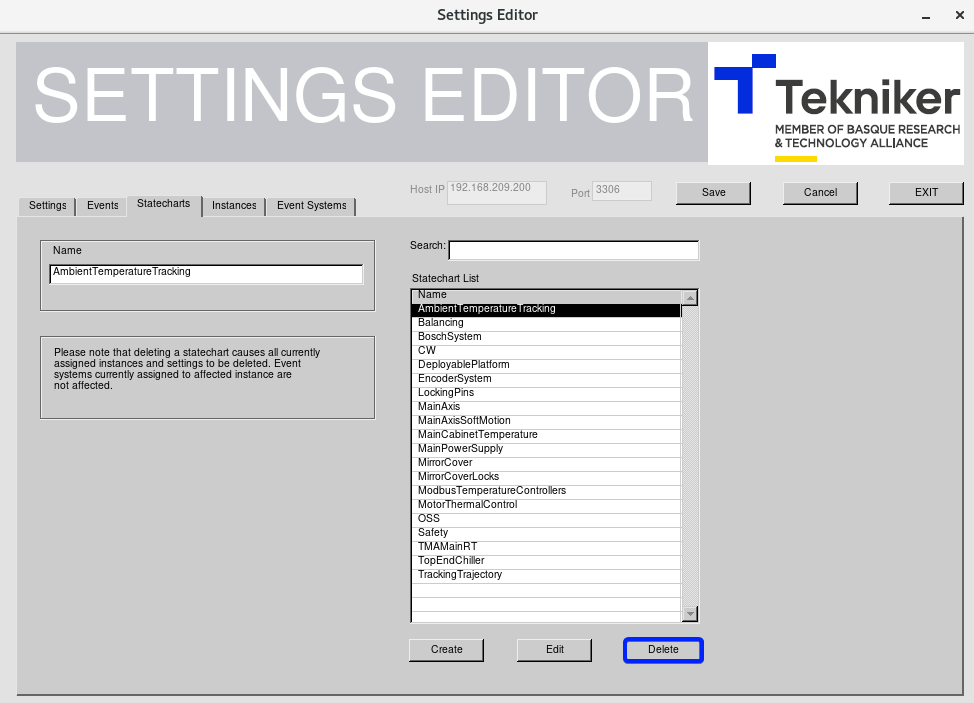
If more than one statechart is going to be removed, repeat the first two steps.
When all the statecharts are modified press the Save button, top right of the application.

Instances¶
Here the instances that are going to be available for the settings are managed, created, modified and deleted.
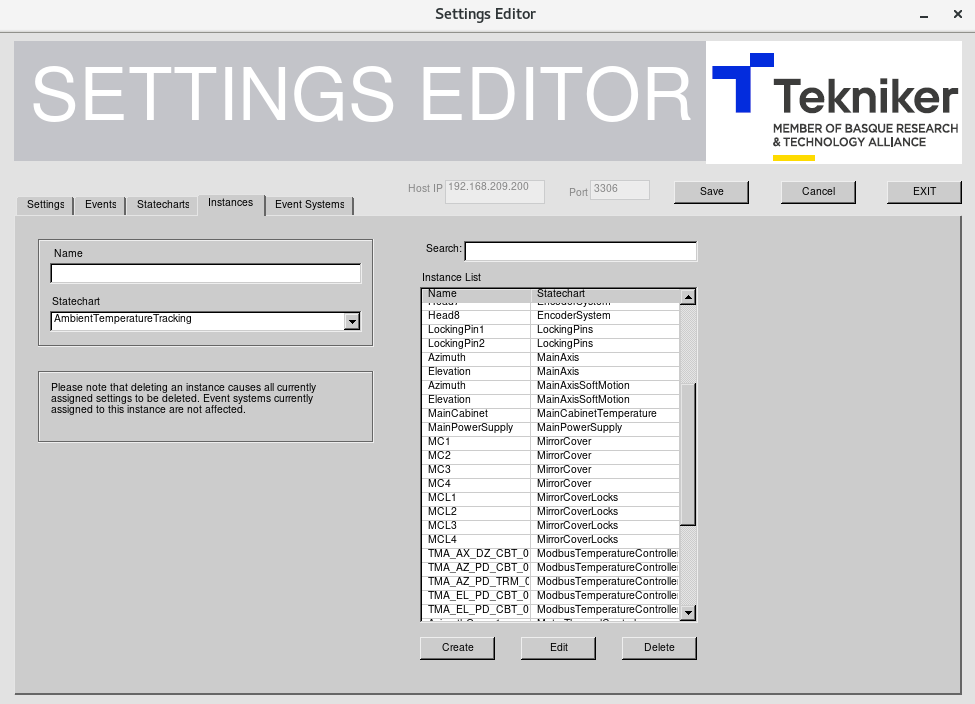
Modifying existing instance¶
Select the desired instance from the
Instance liston the right, this will load the related information on the left:Name: this is the instance name.
Statechart: this is an enum defined in the Statecharts tab and related to the code in the PXIs, as each statechart is a different code module in the PXI code.
Once the left part is updated, the name is changed, press the Edit button on the right.
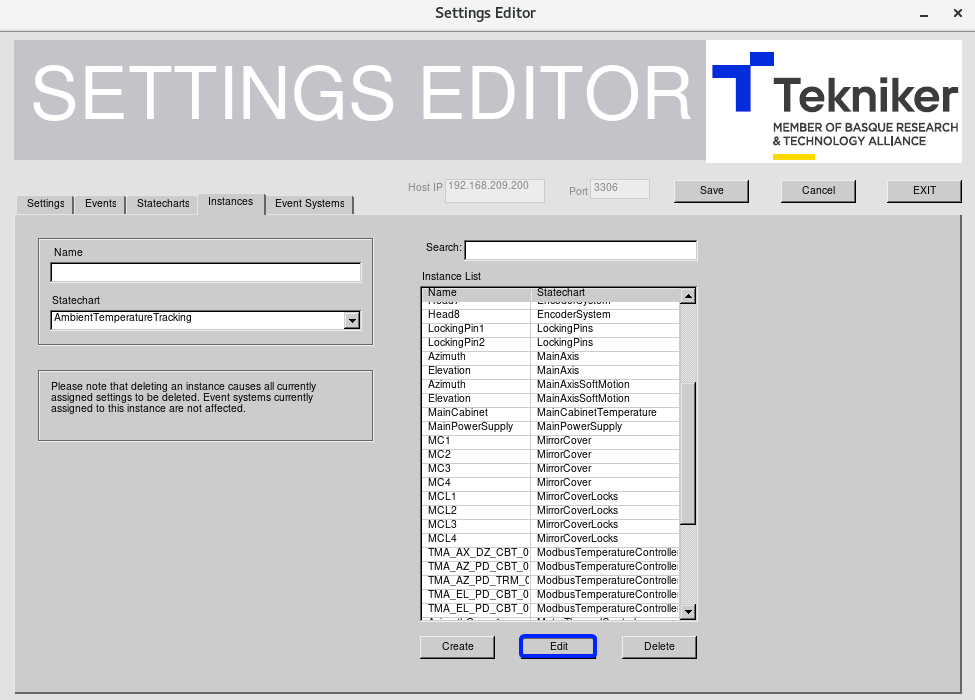
If more than one instance is going to be modified, repeat the first two steps.
When all the instances are modified press the Save button, top right of the application.

Create new instance¶
Add the name for the instance.
Select the related statechart.
Press the Create button on the right.
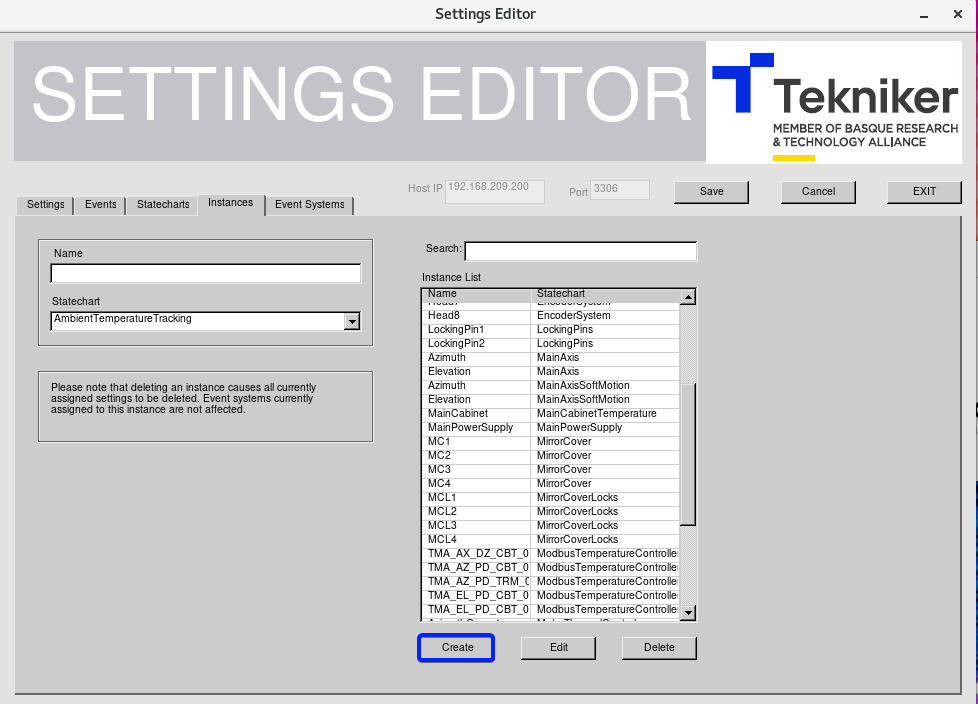
This will create the new instance.
If more than one instance is going to be created, repeat the first two steps.
When all the instances are created press the Save button, top right of the application.

Remove existing instance¶
Note that deleting an instance causes all currently assigned settings to be deleted. Event systems assigned to the related instances are not affected.
Select the desired instance from the
Instance liston the right.Press the Delete button on the right.
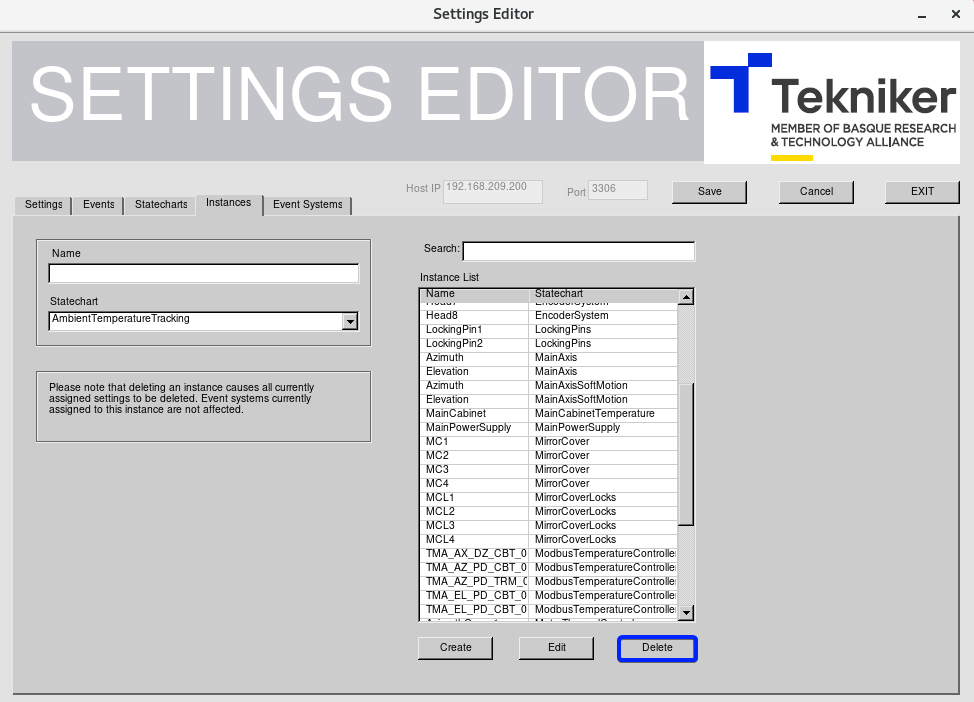
If more than one instance is going to be removed, repeat the first two steps.
When all the instance are modified press the Save button, top right of the application.

Event systems¶
Here the event systems that are going to be available are managed, created, modified and deleted.
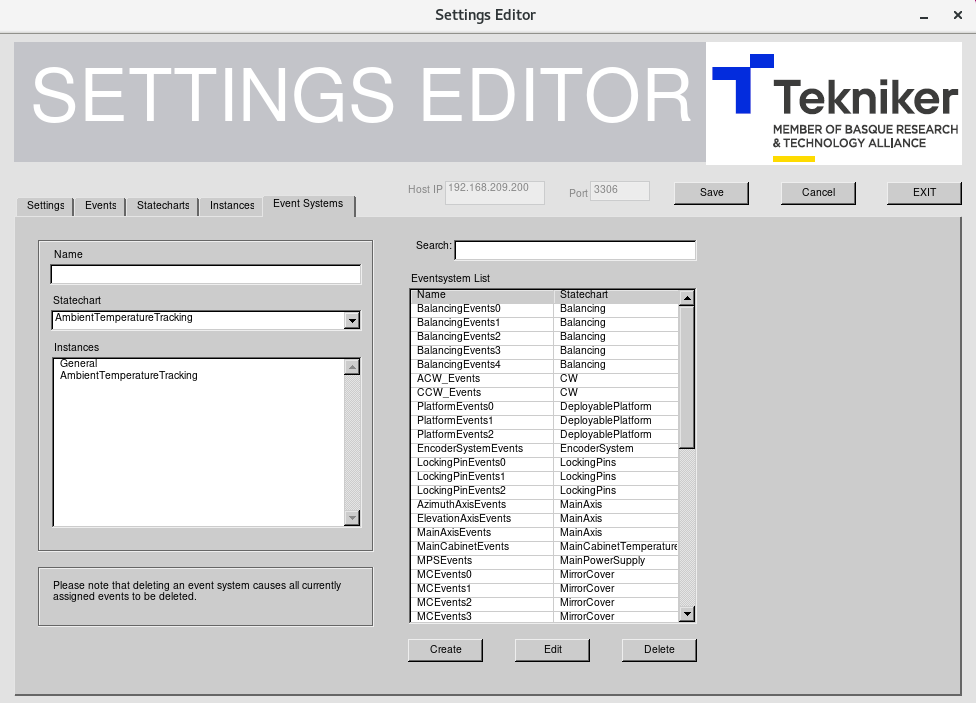
Modifying existing event system¶
Select the desired event system from the
Eventsystem liston the right, this will load the related information on the left:Name: this is the event system name.
Statechart: this is an enum defined in the Statecharts tab and related to the code in the PXIs, as each statechart is a different code module in the PXI code.
Instances: this is an enum with the instances defined in the Instances tab, here select the instances that will be related linked to the event system.
Once the left part is updated, the name is changed, press the Edit button on the right.
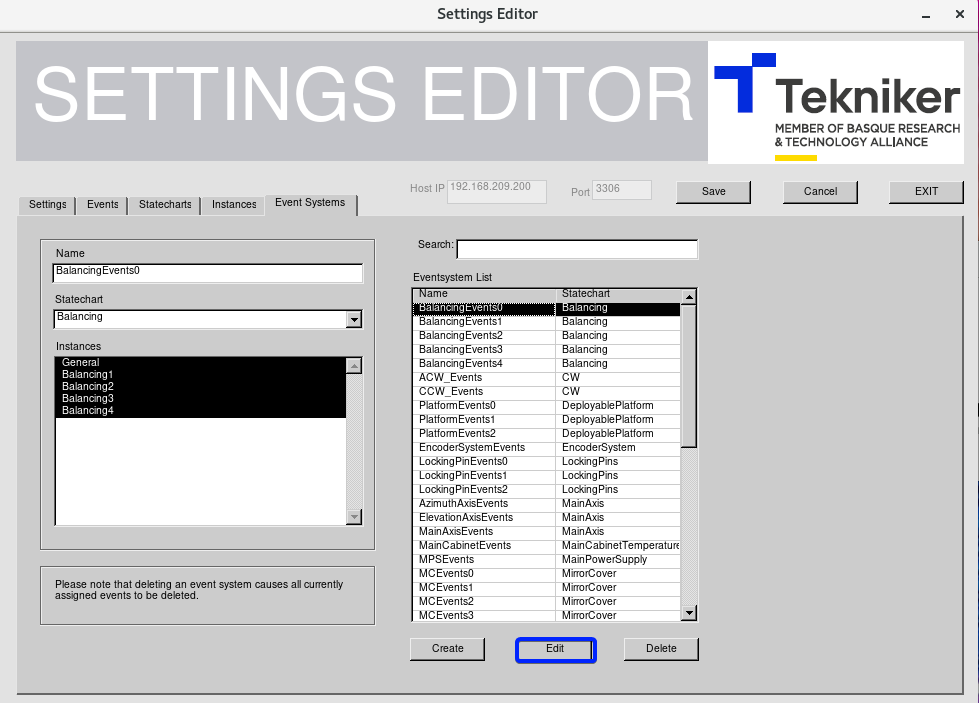
If more than one event system is going to be modified, repeat the first two steps.
When all the event systems are modified press the Save button, top right of the application.

Create new event system¶
Add the name for the event system.
Select the related statechart.
Select the instances that will be related linked to the event system.
Press the Create button on the right.
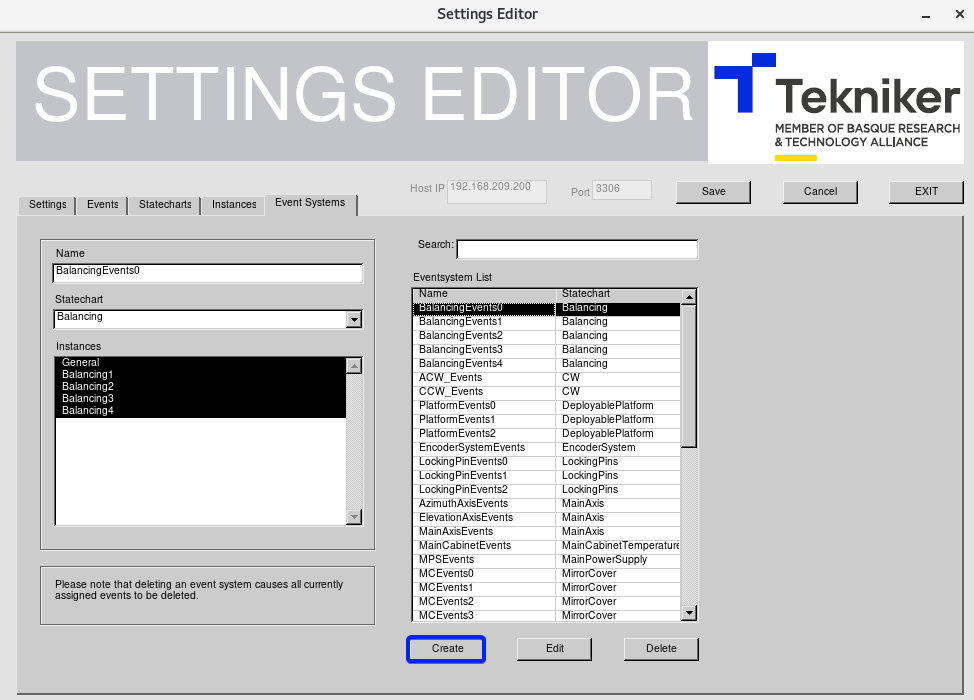
This will create the new event system.
If more than one event system is going to be created, repeat the first two steps.
When all the event systems are created press the Save button, top right of the application.

Remove existing event system¶
Select the desired event system from the
Eventsystem liston the right.Press the Delete button on the right.
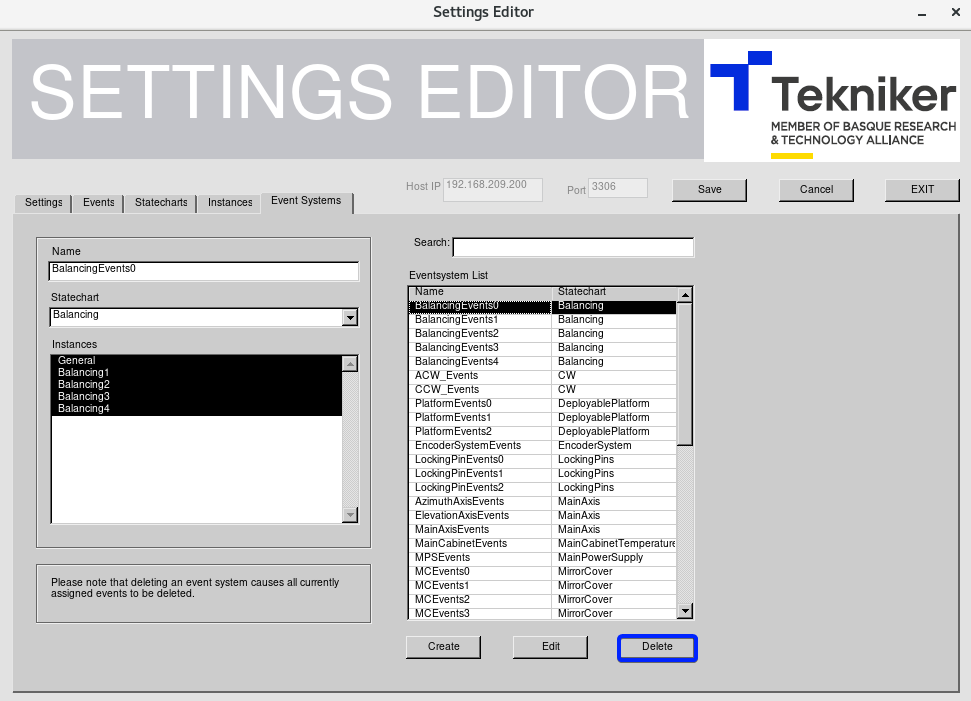
If more than one event system is going to be removed, repeat the first two steps.
When all the event systems are modified press the Save button, top right of the application.
